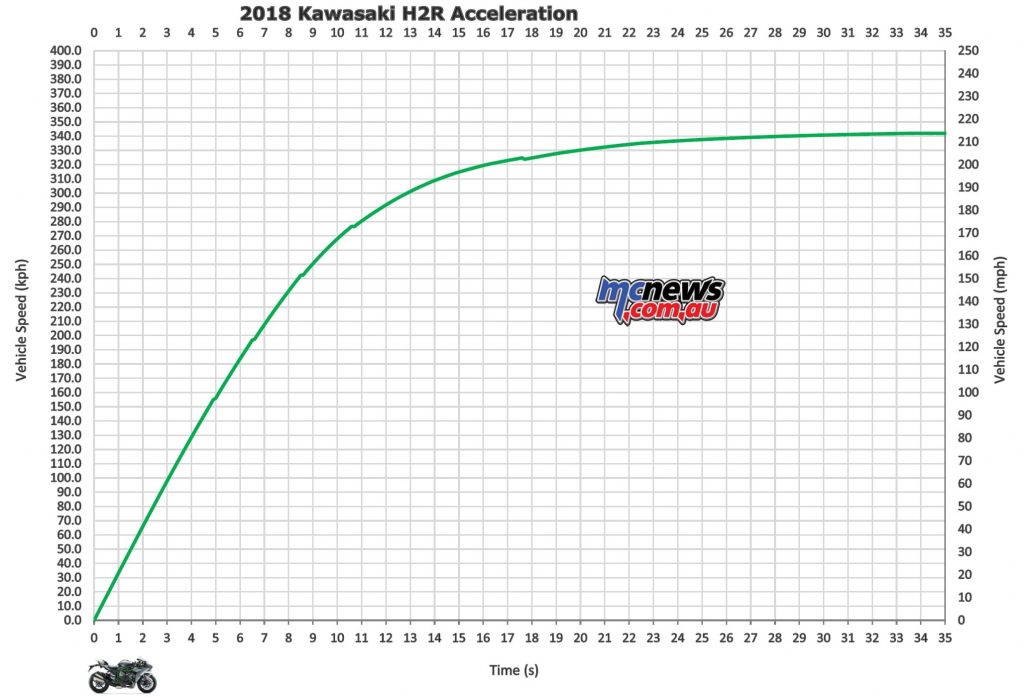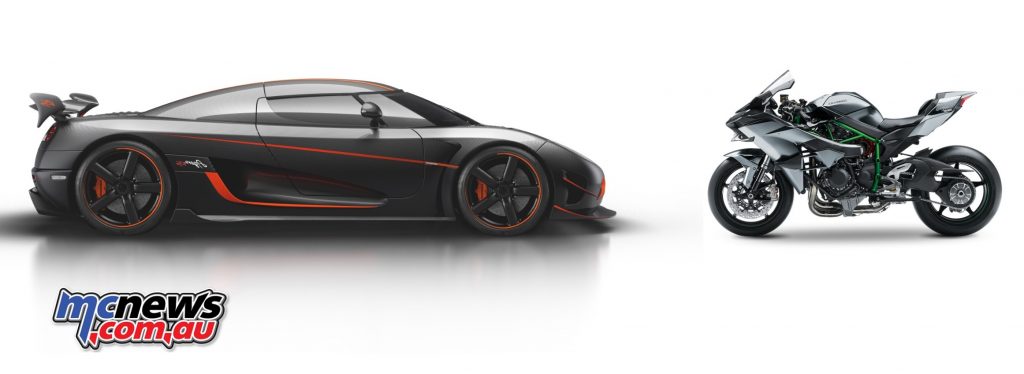MotoGP Vs H2R
Back in July we ran a piece taking a look at how accelerative Dovizioso’s Ducati Desmocedici GP18 might be. We put some numbers through a supercomputer and what we got correlated somewhat accurately to what has been documented.
For some perspective, we also compared the Ducati GP machine with something a little more down to earth. The BMW S1000RR is one of the fastest accelerating production motorcycles to date. Anyone who has ridden an S1000RR will know just how much of a ballistic straight line performer the BMW is, though it is still no match for a dedicated GP bike, as explained in our earlier piece.
The only other motorcycle available to purchase that might stack-up would be Kawasaki’s mighty H2R. Technically, the H2R is a production motorcycle, but one that can’t be ridden on public roads, as the full powered H2R version can’t be registered. In some countries you could probably put lights and indicators on it and legally register it but definitely not here in nanny state Australia. Here you would have to settle for the less powerful, but recently improved and hardly run-of-the-mill, H2 road going bike.
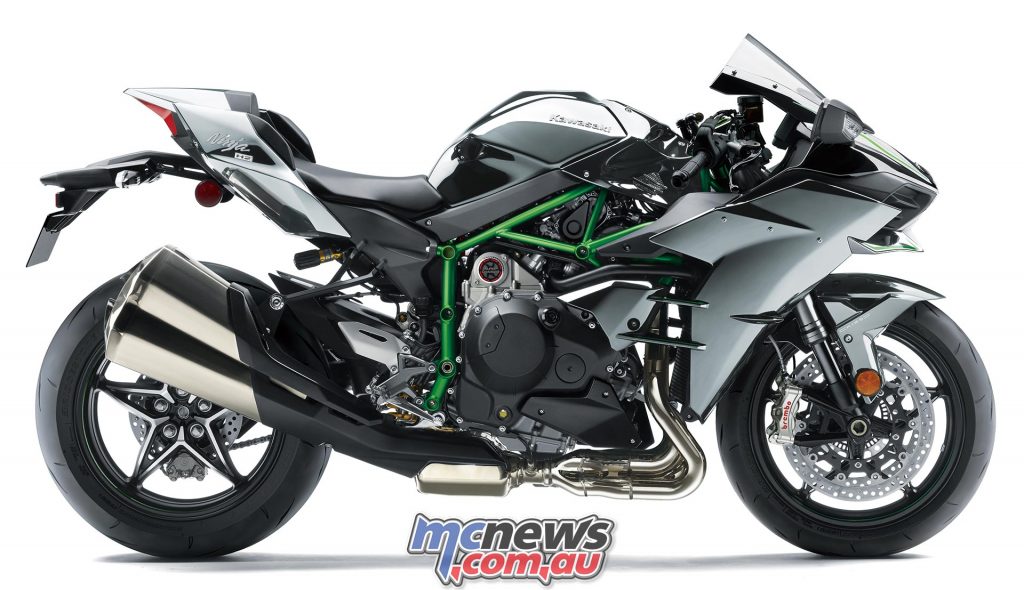
In our original piece, we briefly compared the GP bike with the data available for the Kawasaki H2R that is readily available on the net. This time we thought it fitting to now run the H2R through our supercomputer and to see if our numbers measure up accurately to real life, while also providing a proper graph/visualisation of what it would like to have the two machines go head to head.
Let’s first take a look at the Ducati MotoGP bike numbers.
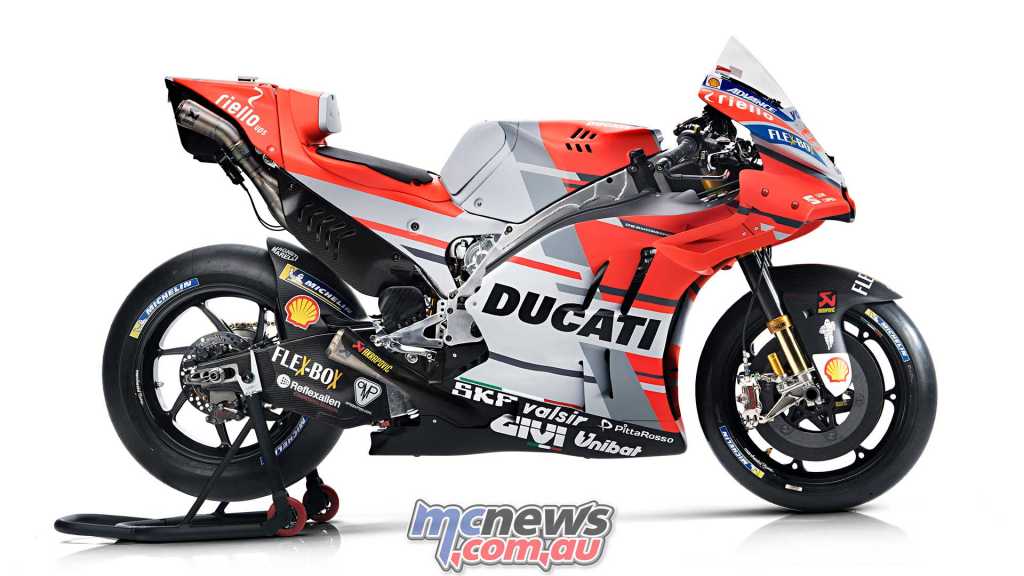 | |
Ducati Desmosedici GP18 | |
Engine | Liquid-cooled, 90° V4, four-stroke, evo desmodromic DOHC, four valves per cylinder |
Capacity | 1,000cc |
Maximum power | Over 250 hp |
Maximum speed | 356.5 km/h (221 mph) Mugello 2018 |
Transmission | Ducati Seamless Transmission (DST_EVO). Chain final drive |
Carburation | Indirect electronic injection, four throttle bodies with injectors above and below the butterfly valves. Throttles operated by the new EVO 2 TCF (Throttle Control & Feedback) system |
Fuel | Shell Racing V-Power |
Lubricant | Shell Advance Ultra 4 |
Exhaust | Akrapovič |
Final Drive | D.I.D Chain |
Frame | Aluminium alloy evo twin-spar |
Suspension | Öhlins inverted 48mm front fork and Öhlins rear shock absorber, adjustable for preload, new factory evolution damping system |
Electronics | Magneti Marelli ECU programmed with Dorna Unified Software |
Tyres | Michelin 17″ front and rear |
Brakes | Brembo, two 340mm carbon front discs with four-piston callipers. Single stainless steel rear disc with two-piston calliper |
Dry weight | 157 kg (346.1 lbs.) |
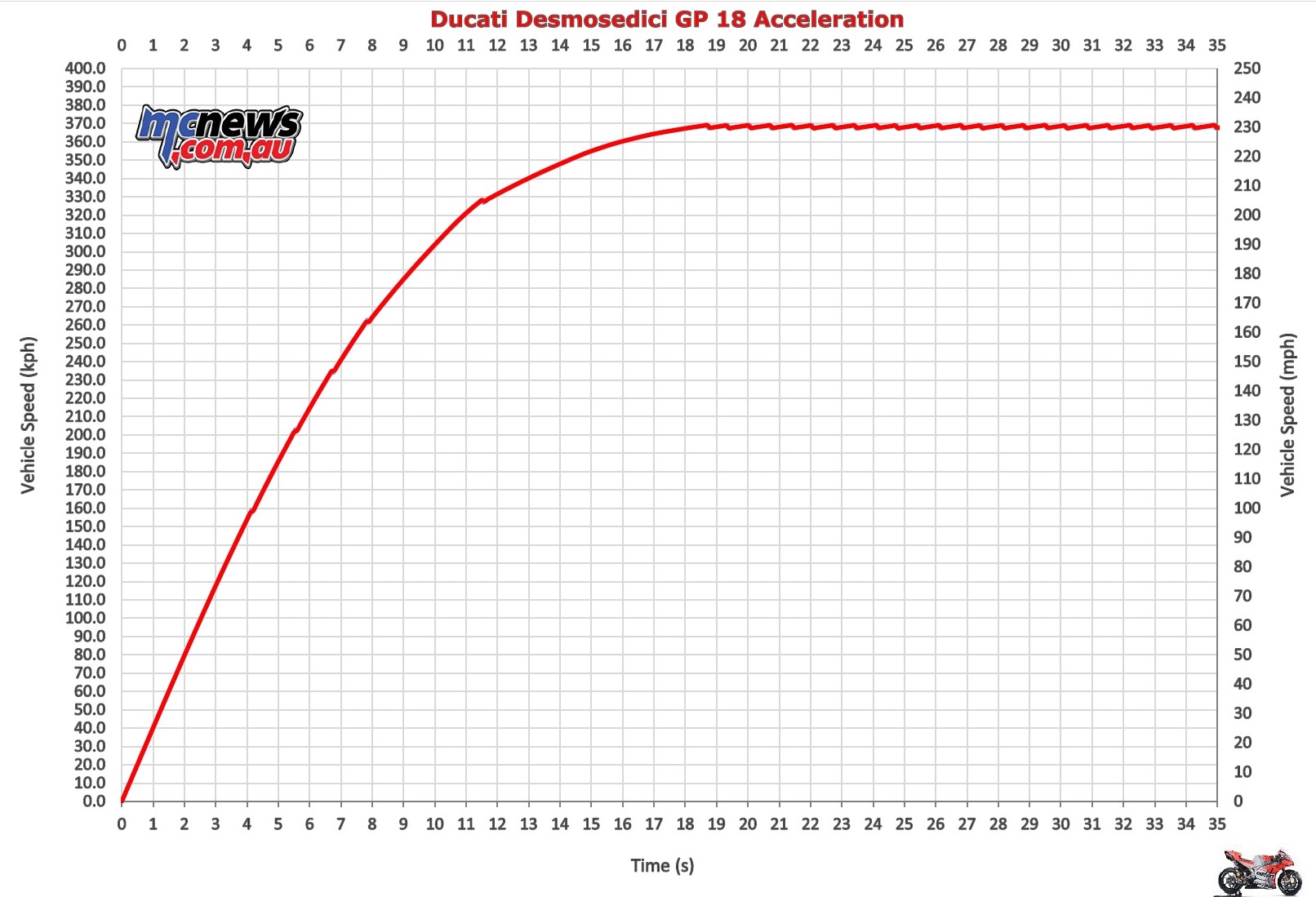
| Ducati Desmosedici GP18 |
| Acceleration From Rest |
| The data used is as closely based upon the Desmosedici GP18 Mugello gearing as we could accurately gauge. The mighty GP18 is ballistic, hitting 350 km/h from rest in 14.27 seconds, and has the power to hit the limiter in top at a giddy 368 km/h. If the Desmo’s frontal area and coefficient drag has been calculated correctly, with long enough gearing and an equally long straight, the Desmo could be good for close to 380 km/h plus. Evident on the acceleration graph are slight dips for the gear changes, as we could not fully simulate a seamless gearbox. We could expect the actual gear changes to be a little quicker in real life, and thus saving even a little more time in the process. Most impressive is not so much how the Desmo rockets from the line, but how it keeps accelerating. Its 200-300 km/h time of 4.33 is only 1.4 slower than its 100-200 km/h time. Even with very advanced electronics it’s still not entirely possible to put all of the Desmo’s power to the ground below 250 km/h, that would require the bike to be stretched and lowered with a wheelie bar and set up for drag racing. Uncensored full-throttle only likely occurs above 250 km/h, and this is why you witness such impressive high speed acceleration for the Desmosedici. Imagine if this engine/box combination was housed in a chassis designed for straight-line performance only, rather than the all round performance benchmark for cornering and braking that it actually is… |
| 100-200 km/h | 2.95 |
| 100-300 km/h | 7.26 |
| 200-300 km/h | 4.33 |
| 300-350 km/h | 4.5 |
| 0-100 km/h | 2.52 |
| 0-160 km/h | 4.23 |
| 0-200 km/h | 5.45 |
| 0-220 km/h | 6.18 |
| 0-240 km/h | 6.96 |
| 0-260 km/h | 7.74 |
| 0-290 km/h | 9.25 |
| 0-300 km/h | 9.72 |
| 0-320 km/h | 10.93 |
| 0-330 km/h | 11.83 |
| 0-340 km/h | 12.98 |
| 0-350 km/h | 14.27 |
| SS/QM | 8.99/284 km/h |
| SS/KM | 15.54/358 km/h |
| S/Mile | 21.44/367 km/h |
| Top Speed | 368 km/h (Rev Limiter) |
Now we’ll take a closer look at Kawasaki’s H2R..
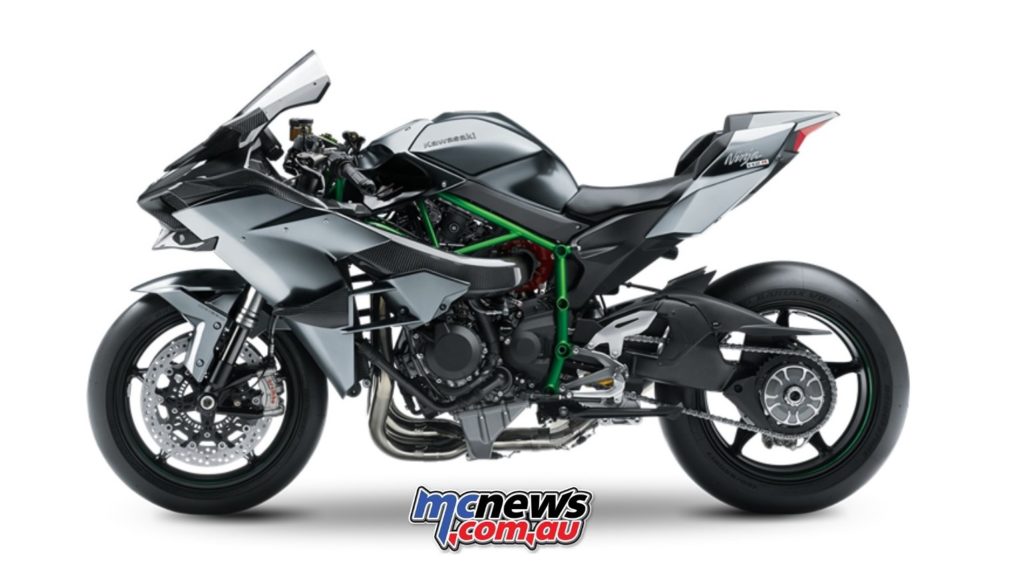
Kawasaki H2R | |
Engine | 4-stroke, 4-cylinder, DOHC, 4-valve, liquid-cooled, supercharged |
Capacity | 998cc |
Maximum power | 326 hp (Crank) 242 hp measured rear wheel. |
Maximum speed | 336 km/h |
Transmission | 6-speed, return, dog-ring |
Carburation | DFI® w/50mm throttle bodies (4) with dual injection |
Final Drive | Sealed chain |
Frame | Trellis, high-tensile steel, with swingarm mounting plate |
Suspension | New Uni-Trak, Öhlins TTX36 gas charged shock with piggyback reservoir, compression and rebound damping and spring preload adjustability, and top-out spring/5.3 in |
Electronics | Kawasaki Corner Management Function (KCMF), Kawasaki Traction Control (KTRC), Kawasaki Launch Control Mode (KLCM), Kawasaki Intelligent anti-lock Brake System (KIBS), Kawasaki Engine Brake Control, Kawasaki Quick Shifter (KQS) (upshift & downshift), Öhlins Electronic Steering Damper |
Tyres | 190/65 ZR17 (78W) / 120/70 ZR17 (58W) |
Brakes | Dual radial-mount, opposed 4-piston calipers, dual semi-floating 330mm discs, KIBS ABS Rear Brakes: Opposed 2-piston calipers, single 250mm disc, KIBS ABS |
Dry weight | 216 kg (476.3 lbs.) |
Lets first clear some things up. Kawasaki’s 326 hp at the crank claim falls rather short when measured at the rear wheel, with most examples of Kawasaki’s H2R knocking out anywhere between 230 hp and 245 hp, depending on the dyno and correction factors used.
Traditionally we see measured rear wheel hp figures around 12 per cent less than the manufacturer’s claims. This is normal, as due to frictional/transmission losses we expect to lose power. If we deduct a 12 percent loss to the Kawasaki’s claimed figure of 326 hp we are still left with 286 hp at the rear wheel, which is 40-50bhp more than what we typically are seeing on dynos. Before we accuse Kawasaki of exaggerated claims, bare in mind that most dyno’s can not replicate a 300km/h plus wind blowing into the air-box. Thus Kawasaki’s hp claim would not be a static claim but more like the power the H2R produces when flat-out, with full ram-air effect and with the supercharger at full efficiency.
Whether this brings up the H2R’s power to the 280s and matches the 12 percent loss is another thing, but we can certainly assume with good accuracy that the H2R will make a little more power when moving versus a static measurement on a rolling road.
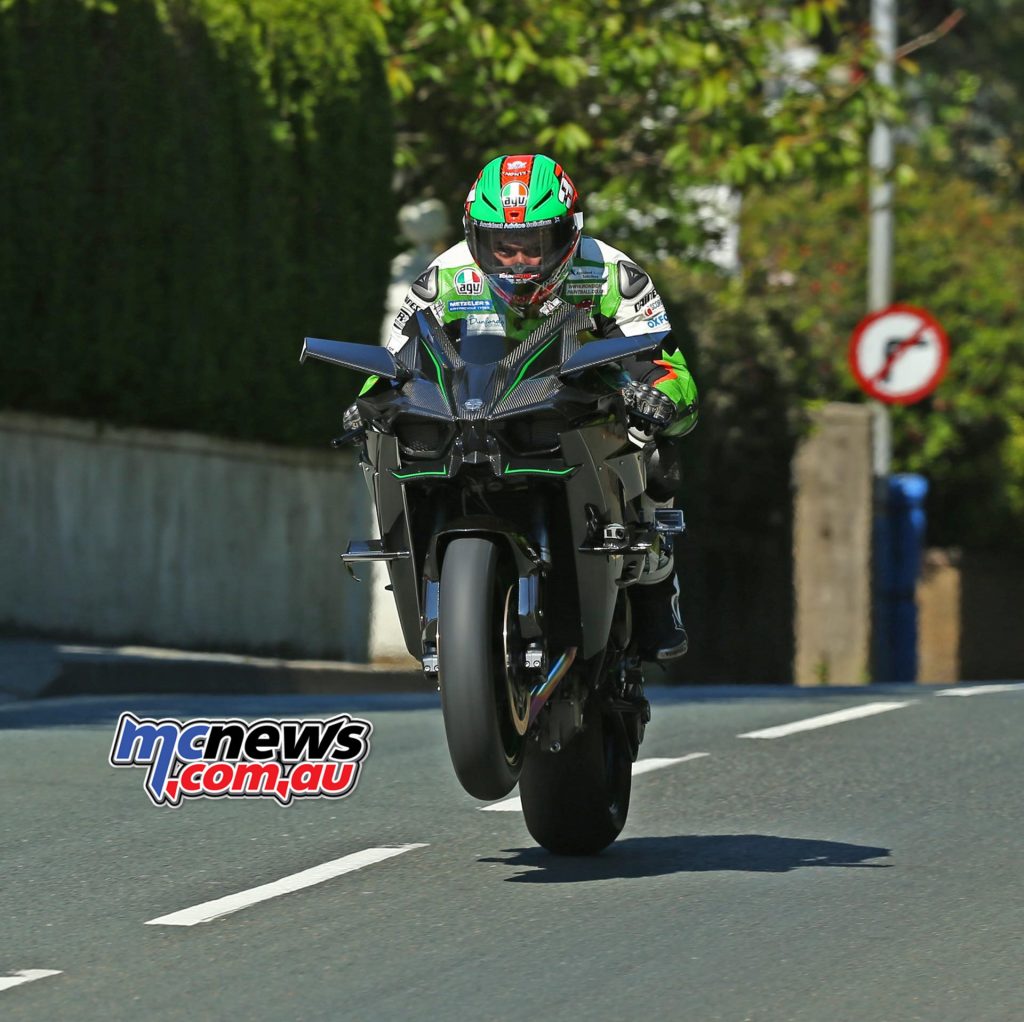
| Kawasaki H2R |
| Acceleration From Rest |
| Unsurprisingly the H2R is the fastest thing from the showroom, though its acceleration advantage over normally aspirated litre bikes’ only really starts to show as speeds get higher. Like most current litre bikes, the H2R is equipped with anti-wheelie and traction control. While very useful and flattering to the average rider, these systems are still a hindrance in optimum straight-line performance for the most skillful riders. The H2R’s acceleration under 260 km/h is still limited due to traction issues, and the inevitable problem of wheelies, thus the H2R does not get to really capitalise on its 50 hp advantage over other litre bikes in the lower gears. Once the H2R can go wide open, it’s not long until aerodynamic inefficiencies start to eat into its big power advantage over the normally aspirated litre bikes, as it hits its peak of around 340km/h. |
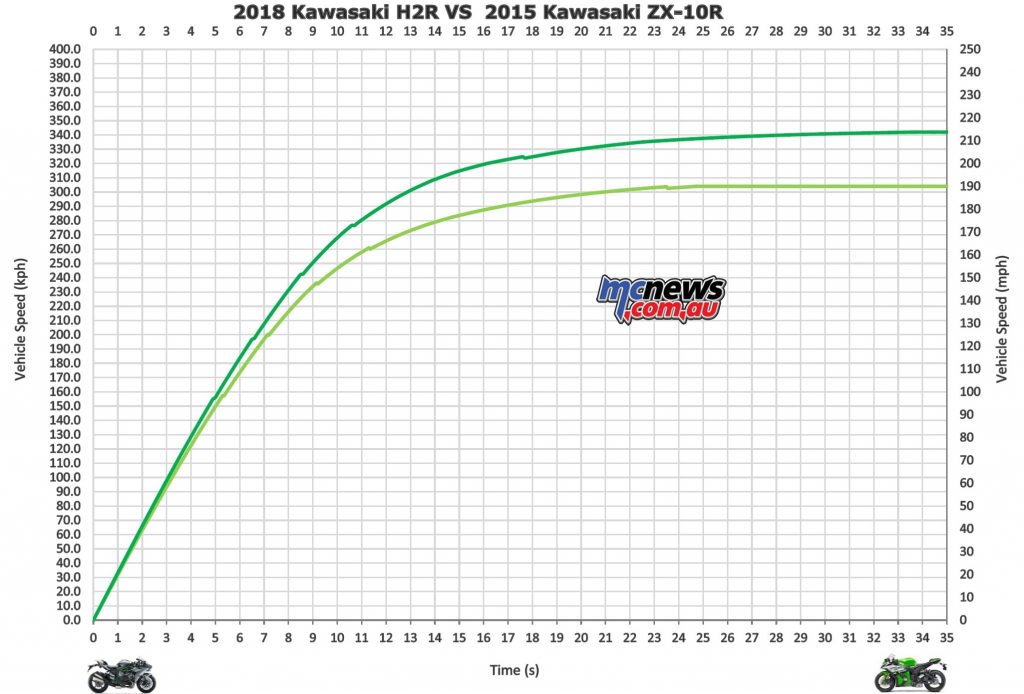
| Kawasaki H2R vs Kawasaki ZX-10R |
| Acceleration From Rest |
| Comparing the H2R to Kawasaki’s flagship litre ZX-10R, you can see that below 200 km/h there really isn’t that much in it. If we lowered the bike and added a little ballast up front, of course then it would be a different story. In standard trim though, it is after 200 km/h where the H2R better converts its supercharged 245bhp in to forward motion, and here is where it starts to gap the ZX-10R convincingly. Looking at the 100 km/h to 300 km/h, and the 200 km/h to 300 km/h times, really stamps home the H2R’s performance advantage over the ZX-10R, much more so than the standing start times. These figures do render just how mind bending the H2R actually is compared to a regular 1000cc sportbike with the blown bike getting from 200 to 300 km/h more than twice as fast as the ZX-10R. |
| From/To | 18 Kawasaki H2R | 15 Kawasaki ZX-10R |
| 100-200 km/h | 3.62 | 4.05 |
| 100-300 km/h | 9.80 | 17.85 |
| 200-300 km/h | 6.17 | 13.80 |
| 300-350 km/h | N/A | N/A |
| 0-100 km/h | 3.07 | 3.18 |
| 0-160 km/h | 5.14 | 5.45 |
| 0-200 km/h | 6.69 | 7.23 |
| 0-220 km/h | 7.51 | 8.35 |
| 0-240 km/h | 8.39 | 9.71 |
| 0-260 km/h | 9.52 | 11.42 |
| 0-290 km/h | 11.84 | 17.15 |
| 0-300 km/h | 12.87 | 21.03 |
| 0-320 km/h | 16.23 | N/A |
| 0-330 km/h | 19.90 | N/A |
| 0-340 km/h | 28.43 | N/A |
| 0-350 km/h | N/A | N/A |
| SS/QM | 9.81/264 km/h | 10.10/248 km/h |
| SS/KM | 16.98/323 km/h | 18.01/294 km/h |
| S/Mile | 23.52/336 km/h | 25.19/302 km/h |
| Top Speed | 342 km/h | 304 km/h |
Kawasaki H2R vs Ducati Desmosedici GP18
Now to the the main event. Let us just get straight to the point. The Ducati Desmosedici pretty much walks away from the H2R from the get go, much like it did to the BMW S1000RR in our previous comparison. Some of you Kawasaki fanboys no doubt may have thought the H2R would have put up a better challenge but put simply, from a standing start, it doesn’t.
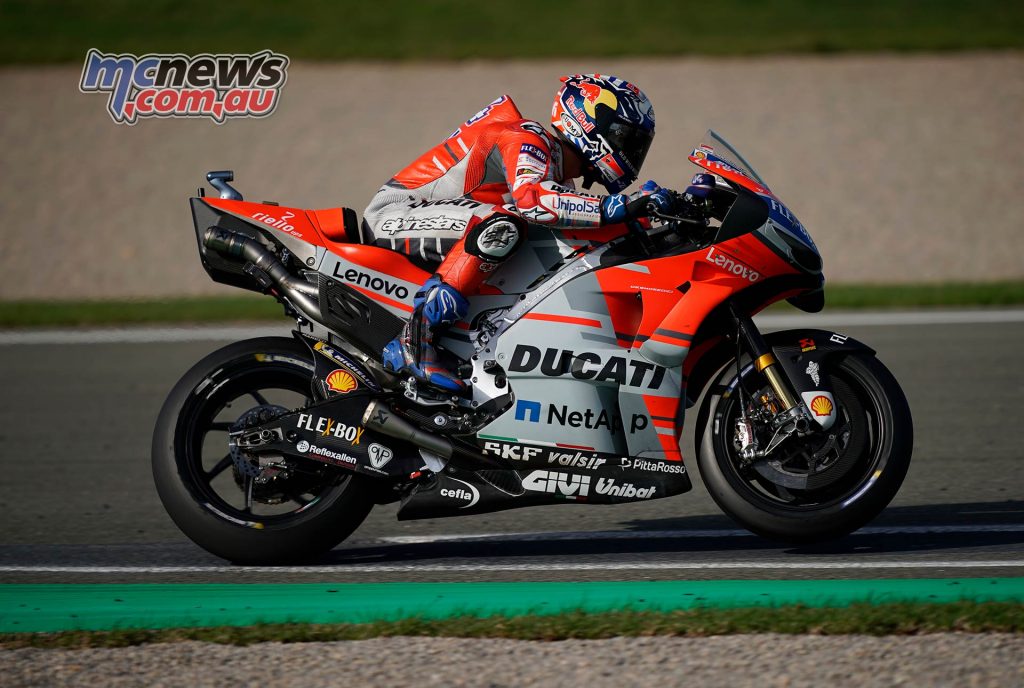
As previously highlighted, the H2R is clearly hindered off of the line, and is not anywhere near as efficicint at putting its power down as the MotoGP machine. What is more impressive is that the MotoGP bike likely has 30/40 odd hp more than the H2R at the wheels, and is of course significantly lighter. It is a testament to the advanced electronic packages of a modern MotoGP bike that these machines actually convert their advantages into a staggering rate of forward motion rather than losing momentum via wheelie or wheelspin.
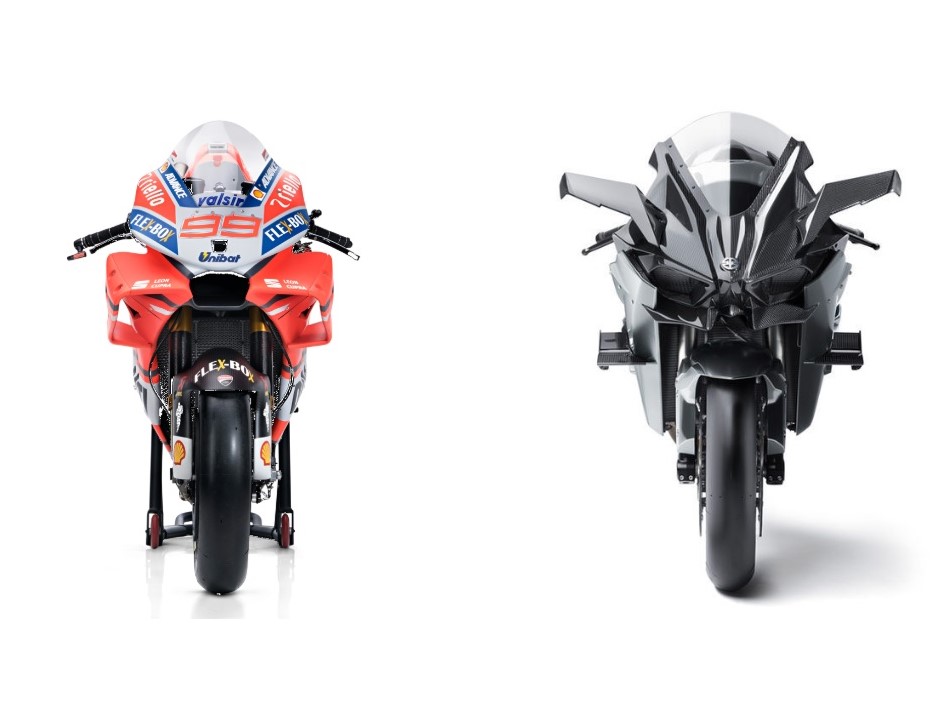 Maybe the H2R can compete once moving? Sure, it does much better, but still trails the GP bike by 2.54 seconds if rolling from 100-300, but only 1.84 seconds from 200-300 km/h. This clearly demonstrates the H2R’s traction hindering brustish power delivery.
Maybe the H2R can compete once moving? Sure, it does much better, but still trails the GP bike by 2.54 seconds if rolling from 100-300, but only 1.84 seconds from 200-300 km/h. This clearly demonstrates the H2R’s traction hindering brustish power delivery.
The H2R comes closest from 200-240 km/h, tailing the GP bike by only 0.2 seconds and taking an impressive 1.70 seconds versus 1.51 seconds for the Ducati MotoGP bike. In a real roll on from those speeds, the H2R would only be trailing the MotoGP bike by a few bike lengths. Impressive stuff.
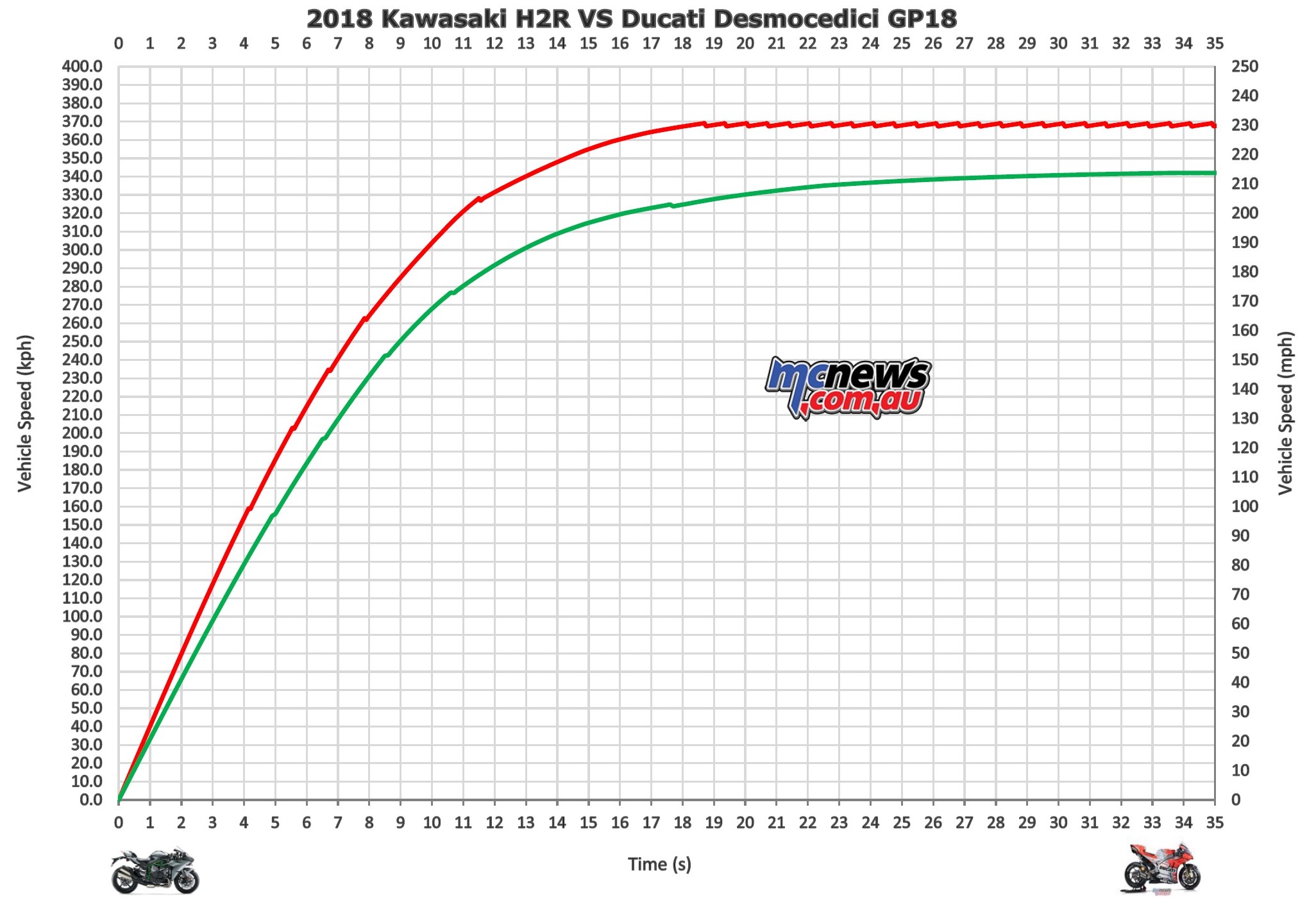
| Acceleration From Rest | ||
| From/To | 18 Kawasaki H2R | Ducati Desmosedici GP18 |
| 100-200 km/h | 3.62 | 2.95 |
| 100-300 km/h | 9.80 | 7.26 |
| 200-300 km/h | 6.17 | 4.33 |
| 300-350 km/h | N/A | 4.50 |
| 0-100 km/h | 3.07 | 2.52 |
| 0-160 km/h | 5.14 | 4.23 |
| 0-200 km/h | 6.69 | 5.45 |
| 0-220 km/h | 7.51 | 6.18 |
| 0-240 km/h | 8.39 | 6.96 |
| 0-260 km/h | 9.52 | 7.74 |
| 0-290 km/h | 11.84 | 9.25 |
| 0-300 km/h | 12.87 | 9.72 |
| 0-320 km/h | 16.23 | 10.93 |
| 0-330 km/h | 19.90 | 11.83 |
| 0-340 km/h | 28.43 | 12.98 |
| 0-350 km/h | N/A | 14.27 |
| SS/QM | 9.81/264 km/h | 8.99/284 km/h |
| SS/KM | 16.98/323 km/h | 15.54/358 km/h |
| S/Mile | 23.52/336 km/h | 21.44/367 km/h |
| Top Speed | 342 km/h | 368 km/h (Rev Limiter) |
Kawasaki’s H2R actually makes for an interesting challenger to a MotoGP bike, as on paper, with its monstrous claimed 326 hp, it certainly qualifies as a worthy competitor. Kawasaki’s claimed 326 hp is a figure higher than even the highest rumoured MotoGP bike power figures we’ve heard of, which range from 280-300hp – claims that are likely at the wheel or gearbox rather than true crank outputs.
In this instance we have to work with rear wheel figures and the H2R’s 230-245 hp is somewhat off of the ‘326 hp’ claim. We all know that it’s not all that hard to get a modern sportsbike up to around 210 hp at the tyre these days. A Factory WSBK racer would be another 20 on top of that, even though recent rpm limits have neutered their potential a little.
WSBK bikes clock demonstrably lower speeds in the traps versus MotoGP bikes on tracks they share, underlining the power and electronic package’ advantages of the prototype MotoGP machines.
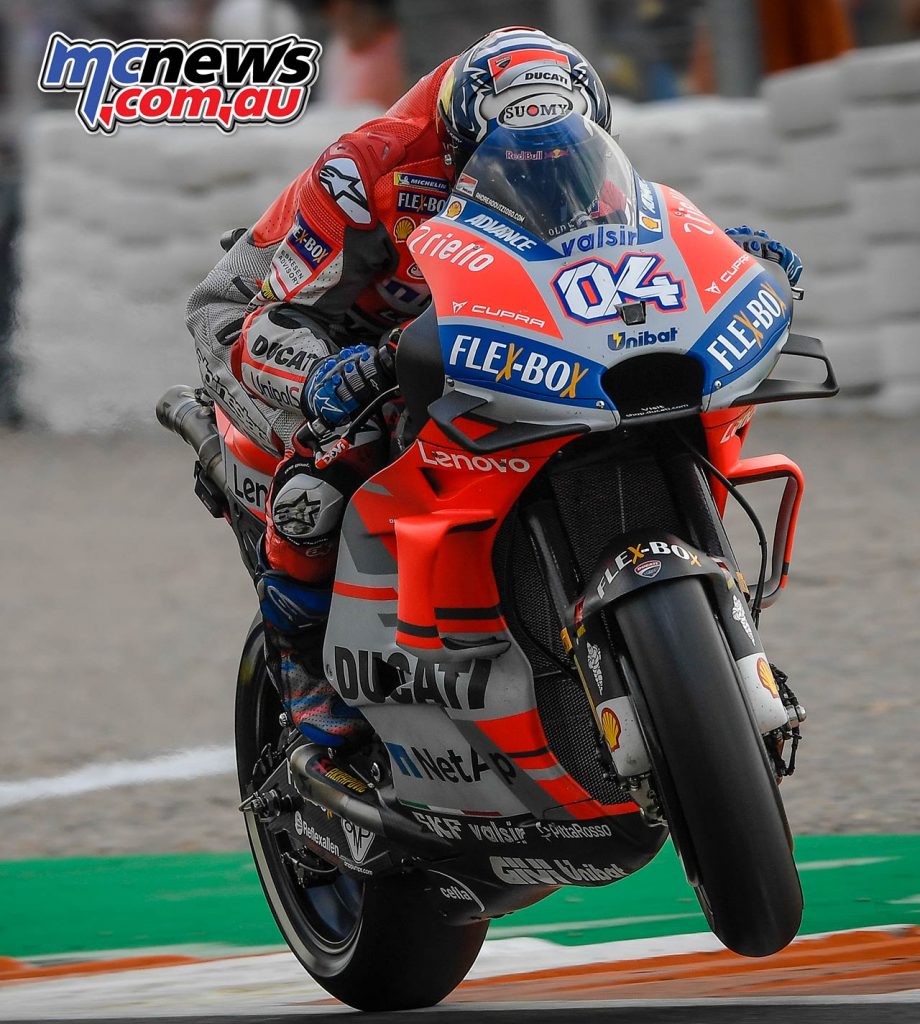
In our previous piece I made an assertion that a H2R would need at least another 40 hp at the wheel to have chance of being a threat against a MotoGP bike, and that claim seems to measure up, at least based upon our simulation. Still, that extra power would only really help the H2R once it was moving and would still be a hindrance off of the line, maybe more so versus the stock bike. That extra 40 hp would have to be accompanied with some fancy electronics to enable that power to get down to the ground and translate into serious forward thrust.
The Kawasaki H2R is a wonderful machine and it is a surprise that in this day and age of health and safety obsessing, that a motorcycle as mad as this exists at all. Good on Kawasaki for having the balls to bring such a machine to market. Sure it is out of the reach of most, but the stock H2 can pretty much be upgraded to a similar level of its mad H2R sibling with some simple bolt-ons and a re-flash, taking the power up to 230 hp plus. Not that a stock H2 is exactly slow or really in need of more power.
The H2R is the the fastest two-wheeled thing from 0-320 km/h that you can buy, and is around 8-10 seconds faster than a Bugatti Veyron to that speed. The only four-wheel production vehicle that might compete would be a Koenigsegg Agera RS. The Koenigsegg is an obscene machine that would even give a MotoGP bike a run for its money. And it is totally legal, albeit a touch expensive, as if it came to Australia it would likely cost you about $5,000,000.
Food for thought maybe for a future comparison…


